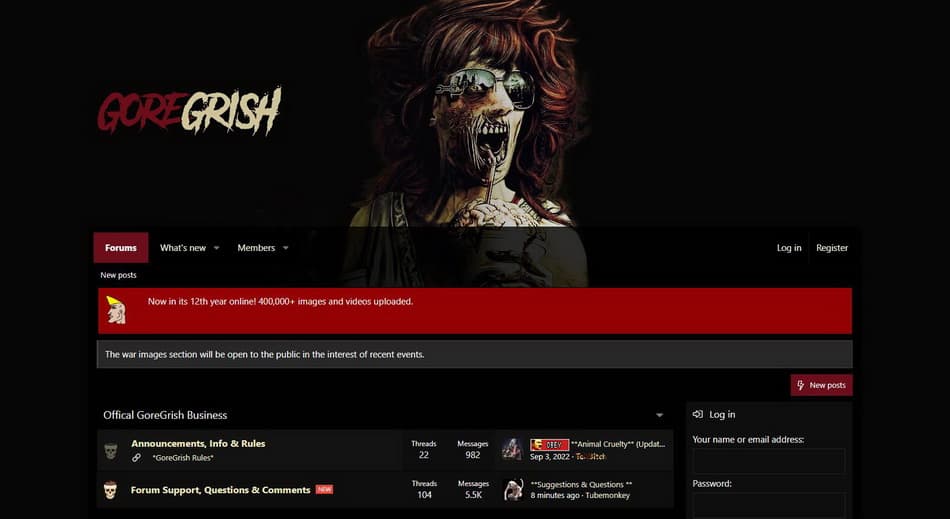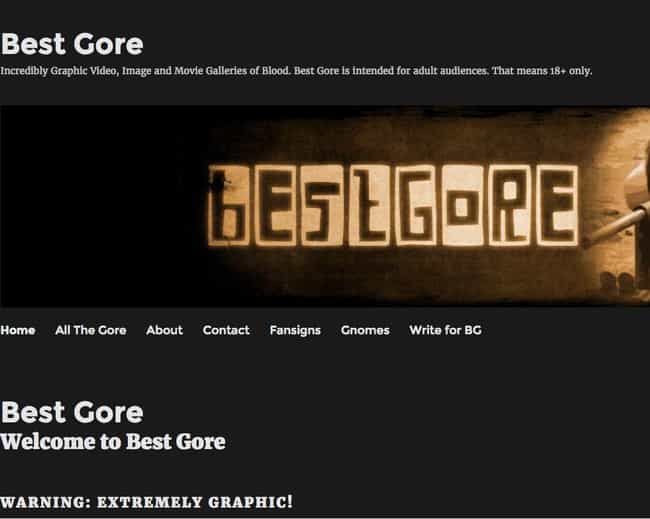Understanding The Gore Site Name: A Look At Disturbing Online Content
Have you ever, perhaps by chance, come across something online that just made your stomach drop? It happens, you know. The internet, for all its good, also holds corners that are, well, quite unsettling. We are talking about places often referred to as a gore site name, which, you know, are digital spaces where people share really graphic, often violent, images or videos. It's a topic that many people prefer to avoid, yet it's out there, and understanding what it is, and why it exists, can be quite important for staying safe online.
For someone just browsing, seeing a gore site name pop up can be a shocking experience, to be honest. These sites typically feature content that shows extreme violence, injuries, or even death, and stuff. It's not something most folks are looking for, yet, in some respects, it's a part of the broader conversation about what lives on the internet. Knowing about these kinds of places helps us talk about online safety more openly, and that's a good thing, you know.
This discussion aims to shed some light on what a gore site name actually means, the kinds of content you might find there, and more importantly, the potential effects of seeing such material. We will also talk about ways to protect yourself and your loved ones from stumbling upon these very disturbing things. It's a serious subject, absolutely, but one that needs a calm, clear look.
- Vintage Family Nudist
- Teach Me First Comic Free
- Video Viral Mayeng003 Portal Zacarias The Talks
- David Bromstad Net Worth
- Xxx Is Equal To 2024 Movie
Table of Contents
- What Exactly is a Gore Site Name?
- The Pull, if you will, and the Problems
- Keeping Yourself and Others Safe from Disturbing Content
- Seeing the Bigger Picture of Online Stuff
- Frequently Asked Questions
- Wrapping Things Up
What Exactly is a Gore Site Name?
When people talk about a gore site name, they are usually referring to a website or an online space dedicated to sharing extremely graphic content. This material often shows real-life violence, like accidents, fights, or other very upsetting events, you know. It's not about fictional horror movies or special effects; it's about actual, raw, and often deeply disturbing scenes. The purpose, if you can call it that, varies. Some sites might claim to be news-related, but many are simply places for people to share or consume shock content, which is, well, pretty much what it sounds like.
These places might have names that sound, you know, a bit edgy or even descriptive of the content they hold. Others might seem quite innocent at first glance, making it harder to know what you're getting into until it's too late. The content can include videos, images, or even written accounts of very brutal things. It's the kind of material that can stick with you for a long time, and not in a good way, you see. It's a stark contrast to the everyday online chats about, say, community experiences at a retail store, like those discussions about Dollar General's policies or employee life, or even finding healthy pet food recipes from places like Badlands Ranch, which, as a matter of fact, supports animal welfare. This just shows how incredibly varied the internet truly is.
Accessing these sites can happen in many ways. Sometimes, it's through a direct search, but often, people stumble upon them through links shared on social media, forums, or even through seemingly innocent searches that lead to unexpected places. It's why being aware of what a gore site name stands for is quite important. Knowing helps you, you know, steer clear. The sheer volume of content out there, both good and bad, means we all need to be a little more careful about where we click, and what we see, honestly.
- Vip Wasmo Telegram Somali
- Wasmo Somali Link Telegram 2025
- Brigitte Macron Young
- Jay Harrington Girlfriend
- Jon Skoog Net Worth
The Pull, if you will, and the Problems
It's a bit strange to think about, but there can be a sort of, well, a pull for some people towards content on a gore site name. Some folks might be driven by curiosity, a desire to see something shocking, or even a morbid fascination. Others might be looking for something that validates their own dark thoughts or experiences. It's a very complex mix of human feelings and impulses, you know. Yet, this pull, however slight, carries with it some really serious problems, both for the person viewing and for the wider online community. It's not just about seeing something gross; it's about what that seeing can do to a person.
The constant stream of graphic material can, arguably, desensitize people to violence, making it seem less impactful or real. This is a pretty big concern, especially for younger people whose views of the world are still taking shape. What might start as a quick look can, over time, become something much more ingrained, and that's a worry, you know. It's like, if you keep seeing something awful, your brain might start to process it differently, less intensely, which is not usually a good thing for empathy or personal well-being. This kind of content, quite honestly, doesn't offer much in the way of positive growth or learning, if you think about it.
How It Might Affect Your Mind
Seeing content from a gore site name can really mess with someone's head, actually. It's not just a fleeting image; it can cause lasting emotional distress. People might experience things like anxiety, nightmares, or even symptoms that look a lot like post-traumatic stress. It's a bit like witnessing something terrible in real life, but from the safety, or lack thereof, of your screen. Your brain, you know, still processes it as a threat, or at least something deeply upsetting, even if you are not physically there. This can be especially true for those who are already feeling a bit vulnerable or going through a tough time, which is something to keep in mind.
For some, this exposure might lead to a skewed view of the world, making them believe that violence is more common or acceptable than it truly is. It can erode a sense of safety and trust in others, making daily life feel more threatening. Think about it: if you're constantly seeing the worst of humanity, it's hard to hold onto hope or believe in the good in people, you know? This kind of content, quite frankly, doesn't really help anyone build a healthy outlook on life. It's a serious consideration for anyone who might accidentally or intentionally come across it, so.
Rules and Right and Wrong
The legal side of a gore site name is, you know, a bit murky sometimes. In many places, simply viewing graphic content isn't illegal, unless it involves certain things like child exploitation, which is absolutely against the law everywhere. However, creating or distributing such content can definitely cross legal lines, especially if it involves real harm or illegal acts. It's a complex area because different countries have different rules about what's allowed online and what's not. This means a site that's okay in one spot might be totally illegal in another, which is a tricky situation, to be honest.
Beyond the law, there's the whole question of what's right and what's wrong, ethically speaking. Many people feel that sharing such content is deeply disrespectful to the victims and can cause more pain. It also raises questions about privacy and consent, especially when real people are involved without their permission. It's a pretty heavy topic, you know, and it makes you think about the responsibilities we all have when we share things online. It's not just about what you can do, but what you should do, in a way.
Staying Safe Online
The internet, for all its good, does have these darker corners, and a gore site name is a prime example. Keeping yourself and your family safe means being aware, you know. It means setting up filters, talking openly about what's online, and knowing when to just, you know, close a tab. It's not about being scared of the internet, but about being smart about it. We teach kids to look both ways before crossing the street; this is sort of the digital version of that, in some respects.
It also involves being careful about what links you click, even from people you know. Sometimes, things get shared that are, well, not what they seem. A quick check before clicking can save you from seeing something you really wish you hadn't. It's about being proactive, basically, rather than reactive. Staying informed about current online dangers, even if they seem unpleasant to think about, can really make a difference in keeping your online experience a positive one, which is, you know, what we all want.
Keeping Yourself and Others Safe from Disturbing Content
Protecting yourself and those you care about from stumbling onto a gore site name or similar disturbing content is, frankly, a really important part of being online today. It's not about building a wall around the internet, but more about putting up some helpful guideposts and safety nets. Think of it like teaching someone to swim; you give them the skills and tools to navigate the water safely, rather than just telling them to avoid it completely. It's a continuous effort, but it's totally worth it for peace of mind, you know.
This protection involves a few different layers, from the technical things you can set up on your devices to the open conversations you have with people, especially younger ones. It's about empowering everyone to make smart choices online and to know what to do if they do see something upsetting. Nobody wants to see things that cause distress, so taking these steps can really help keep the online world a more comfortable place, which is something we all pretty much want, at the end of the day.
Blocking Things You Don't Want to See
One of the most practical steps you can take is to use content filters and parental controls. Most internet service providers offer these, and browsers also have settings that can help block or warn you about certain types of content. These tools are pretty good at catching a lot of the really graphic stuff before it even shows up on your screen. It's not a perfect solution, no system is, but it definitely cuts down on the chances of accidentally seeing a gore site name or similar material, you know. Think of it as a first line of defense, so.
Beyond that, teach yourself and others about safe browsing habits. This means being wary of strange links, especially those sent from unknown sources or promising something too good to be true. Sometimes, a link that looks innocent can lead to some very dark places. It's a good idea to hover over links before clicking, to see where they actually lead. This simple habit can save you a lot of trouble, honestly. And remember, if something feels off, it probably is, which is a good rule of thumb online.
Talking with Younger Folks
Having open, honest talks with young people about what they might encounter online is, perhaps, the most important thing. Kids are curious, and they might stumble upon a gore site name or other disturbing content without even looking for it. Instead of just forbidding things, talk about why certain content is harmful and what it can do to their minds. Make it clear that they can come to you if they see something upsetting, without fear of getting into trouble. This creates a safe space for them to share their experiences, you know.
Encourage critical thinking. Teach them to question what they see online, to think about who created it and why. Not everything on the internet is real or true, and some things are put there just to shock or provoke. Helping them understand this can make a big difference in how they react to disturbing material. It's about building their resilience, basically, so they can handle the unexpected. This ongoing conversation is really, really key, to be honest.
Getting Some Help
If you or someone you know has seen content from a gore site name and is struggling with it, getting help is absolutely okay. There are mental health professionals who specialize in trauma and online exposure. They can provide tools and strategies to process what was seen and to cope with any lasting effects. It's not a sign of weakness to seek support; it's a sign of strength, you know. Your well-being matters, and there are people who can help you work through these tough experiences.
Online support groups or forums can also be a place to connect with others who have similar experiences, though it's important to choose reputable ones. Sharing your feelings with trusted friends or family can also be very helpful. Remember, you don't have to go through this alone. The impact of such content can be significant, so reaching out is a really good step. There are resources out there, you just need to find them, and that's a good thing, you know.
Seeing the Bigger Picture of Online Stuff
Thinking about a gore site name really brings into focus the incredibly vast and, honestly, sometimes wild nature of the internet. It's a place where you can find nearly anything, from incredibly helpful information and heartwarming stories to, well, the very worst of human behavior. This wide range of content means that as internet users, we all need to develop a pretty strong sense of digital literacy. It's not just about knowing how to click and type; it's about understanding the good, the bad, and the sometimes truly ugly aspects of being connected, you know.
The online world is, in a way, a reflection of our own world, with all its light and shadow. While discussions about things like online retail experiences, for example, talking about how Dollar General operates or what it's like to work there, or even sharing pet health tips from places like Badlands Ranch, fill a huge part of the internet, the darker corners, like those containing a gore site name, also exist. Acknowledging this reality, without dwelling on it, helps us to be more prepared and to promote safer online environments for everyone. It's about being aware of the full spectrum of what's out there, basically.
Staying informed about new online trends and threats is also a good idea. The internet is always changing, and what's a concern today might be different tomorrow. Keeping up with these changes helps you adapt your safety strategies. This might mean reading articles from reputable sources about online safety or listening to experts who talk about digital well-being. It's a bit like staying current with news, but for your online life, which is, you know, pretty important these days. The more we understand, the better we can protect ourselves and others, honestly.
Frequently Asked Questions
What kind of content is on a gore site?
Content on a gore site name typically includes very graphic and disturbing images or videos of real-life violence, accidents, injuries, or even death. It's not usually fictional or special effects, but rather raw, unedited footage that can be extremely upsetting, you know. It's meant to shock, and it often does, to be honest.
Are gore sites illegal?
The legality of a gore site name can vary quite a bit depending on where it's hosted and what specific content it shows. In many places, simply viewing graphic content isn't illegal, but creating or distributing it, especially if it involves illegal acts or exploitation, is definitely against the law. It's a complex area with different rules in different countries, so.
How does viewing gore content affect a person?
Viewing content from a gore site name can have some really serious negative effects on a person's mental well-being. It can lead to things like anxiety, nightmares, emotional distress, and even a feeling of being numb to violence. It can also, you know, change how someone views the world, making it seem more dangerous or harsh, which is something to consider.
Wrapping Things Up
So, we've talked a bit about what a gore site name actually is, and the very real problems that come with encountering such content online. It's clear that these parts of the internet are not for casual viewing and can have some pretty deep effects on people. Understanding this is, arguably, a first step towards protecting ourselves and others. The internet is a huge place, filled with all sorts of things, and knowing where the dangers lie helps us enjoy the good parts more safely, you know. For more on mental well-being and online experiences, you can check out resources from health organizations.
Staying safe online means being aware, setting up protections, and having honest talks with those around you. It's about making smart choices every time you click, and knowing that help is available if you or someone you know needs it after seeing something upsetting. We can learn more about online safety on our site, and you can also find helpful information about digital well-being practices to keep your online experience positive and secure.
- Hanalei Swan The 30m Shark Tank Deal She Turned Down Ndash What Happened
- Why Did Ryan Gosling Take 4 Years Off
- Jon Skoog Net Worth
- %D8%B3%D9%83%D8%B3 %D9%85%D9%8A%D8%B1%D9%86%D8%A7
- Experience The Incredible Mayengg03 Viral Original Video

12 beste Websiten wie BestGore für schockierende Videos | Leawo

The 14 Creepiest Websites On The Internet You Shouldn't Visit

Gore and violent extremism: How extremist groups exploit ‘gore’ sites